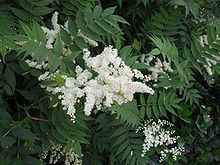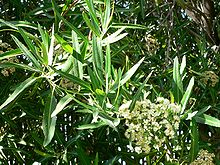Spiraeoideae
| Spiraeoideae | ||||||||||||
|---|---|---|---|---|---|---|---|---|---|---|---|---|

Forest goat's beard ( Aruncus dioicus ) |
||||||||||||
| Systematics | ||||||||||||
|
||||||||||||
| Scientific name | ||||||||||||
| Spiraeoideae | ||||||||||||
| C. Agardh |
The Spiraeoideae are a subfamily of the rose family (Rosaceae). After molecular genetic investigations, the subfamily was expanded and also includes the pomaceous fruit plants (now Subtribus Pyrinae) and stone fruit plants (genus Prunus ) , which were previously run as separate subfamilies .
features
The representatives are mainly shrubs and trees. The leaves are mainly simple and alternate and have stipules . The flower cup (hypanthium) is usually not fused with the carpels . These are also free and not grown together.
fruit
In the classical system, which is based on morphological instead of molecular criteria, the apple and stone fruit-forming rosaceae do not belong to the subfamily Spiraeoideae. According to this morphological view, the Spiraeoideae are characterized by the follicle fruit . The follicles arise from a five-fold flower with three or more stamen circles and a carpel circle. The carpels of these follicles are then either free-standing ( apocarp ) or only fused at the base. The achenes are also mentioned differently as a possible type of fruit among the sparaceae species (see below), which, however, is not an appropriate designation from a botanical point of view.
From the molecular point of view, stone and pome fruit plants belong to the Spiraeoideae. This adds to the follicle fruits the collective capsule fruits (coccetum), stone fruits or apple fruits . In addition, the flower formula mentioned, which then no longer includes all assigned species, is no longer applicable.
Cyanogenic glycosides are common and sorbitol is formed in significant amounts. The basic chromosome numbers are x = 8, 9, 15, or 17.
Controversy
The naming of the fruit types of the Spiraeoideae in the specialist literature is overall inconsistent, which is also reflected in the description of the Spiraeoideae. For example, Klein speaks of the strawberry “achenes sitting on the flower base”, while other botanists “require a subordinate ovary” as a necessary criterion for the achenes, which is not the case with the common nut fruit of Fragaria . For laypeople, terms such as “bellows-like nuts” can also be confusing, since the nuts of the meadowsweet do not open up to scatter seeds like a bellows fruit.
Systematics
The scope of the Spiraeoideae was significantly expanded by Potter et al. (2007) on the basis of molecular genetic investigations, the pome fruit and stone fruit plants , which were previously managed as separate subfamilies, were integrated into the Spiraeoideae.
The subfamily consists of seven tribes and two genera that are not assigned to any tribe.
- Tribe Amygdaleae
The tribe Amygdaleae corresponds to the earlier subfamily stone fruit plants with the only and very species-rich genus:
- Prunus .
- Tribe Neillieae
The tribe Neillieae has fused carpels, the fruit is a pelvic fruit. The stipules are obsolete, cyanogenic glycosides seem to be absent. The basic chromosome number is x = 9.
- Physocarpus
- Neillia (including Stephanandra )
- Tribe Sorbarieae
The Sorbarieae have alternate and compound leaves, Adenostoma has whorled to alternate, simple leaves. The carpels are fused, the fruit is an achenes or a pelvis fruit. The basic chromosome number is x = 9.
- Adenostoma
- Pinnate sparrow ( Sorbaria )
- Chamaebatiaria
- Spiraeanthus
- Tribe Spiraeeae

The Spiraeeae are herbaceous plants or shrubs and sometimes form rosettes. Stipules are missing, the fruits are pelvic fruits or collective awnings The basic chromosome number is x = 9.
- Goat's beard ( aruncus )
- Kelseya
- Luetkea
- Petrophyton
- Sibiraea
- Spear bushes ( Spiraea )
- Xerospiraea
- Holodiscus
Supertribus Kerriodae
The Kerriodae D. Potter, SH Oh, KR Robertson are molecular genetically defined as a monophyletic taxon and comprise two tribes.
- Tribe Osmaronieae
The stipules are missing or obsolete, the fruit is a coccetum, a stone fruit or a collective stone fruit. The basic chromosome number is x = 8.
- Tribus Kerrieae
The fruit is mostly a Nuculanium (similar to stone fruit, but with a dry pericarp), in Neviusia a collective achenes. The basic chromosome number is x = 9 (for Coleogyne 8).
Supertribus Pyrodae
The Supertribus Pyrodae CS Campbell, RC Evans, DR Morgan & TA Dickinson includes a genus and a tribe. They are perennial herbaceous plants, shrubs or trees. In some genera the leaves are compound. The carpels are mostly fused. The ovules are basal and exist in twos. The species are hosts of the rust fungi Phragmidium and Gymnosporangium .
- Tribus Pyreae
The Pyreae comprise a subtribe and three genera that are not assigned to any subtribe. The base chromosome number is x = 17 (in Vauquelinia 15).
- Kageneckia
- Vauquelinia
- Lindleya
- Subtribus Pyrinae ( pome fruit family , formerly Maloideae)
supporting documents
- D. Potter, T. Eriksson, RC Evans, S. Oh, JEE Smedmark, DR Morgan, M. Kerr, KR Robertson, M. Arsenault, TA Dickinson, CS Campbell: Phylogeny and classification of Rosaceae. In: Plant Systematics and Evolution. Volume 266, 2007, pp. 5-43. doi: 10.1007 / s00606-007-0539-9
Individual evidence
- ↑ D. Klein: NAD (P) H-dependent enone oxidoreductases of the strawberry and tomato fruit. Dissertation. FZ Weihenstephan, 2007, p. 27.
- ^ Gerhard Wagenitz : Dictionary of Botany. Morphology, anatomy, taxonomy, evolution. 2nd, expanded edition. Nikol, Hamburg 2008, ISBN 978-3-937872-94-0 , p. 166.
- ↑ R. Lüder: Basic course in plant identification. 4th edition. Quelle & Meyer Verlag, Wiebelsheim 2008, p. 154.


